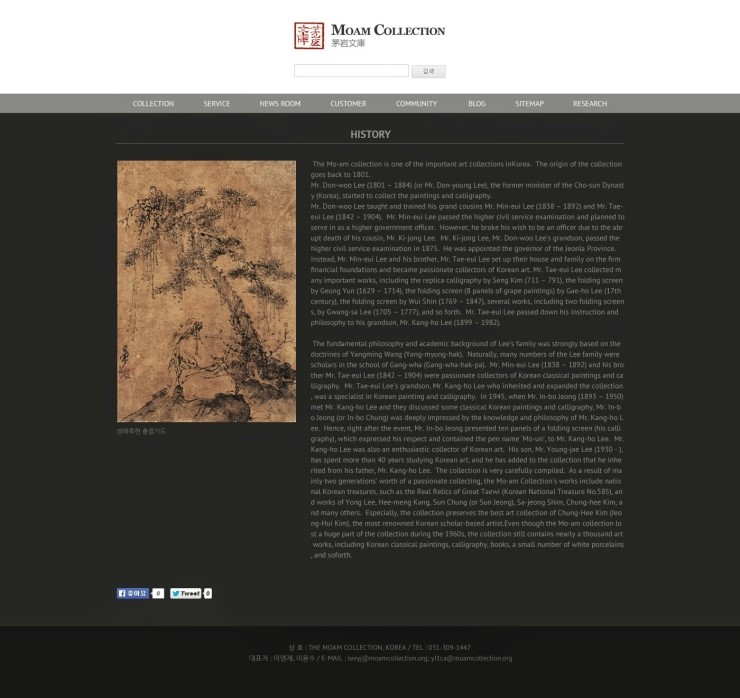
The Mo-am collection is one of the important art collections in Korea. The origin of the collection goes back to 1801. Mr. Don-woo Lee (1801 – 1884) (or Mr. Don-young Lee), the former minister of the Cho-sun Dynasty (Korea), started to collect the paintings and calligraphy. Mr. Don-woo Lee taught and trained his grand cousins Mr. Min-eui Lee (1838 – 1892) and Mr. Tae-eui Lee (1842 – 1904). Mr. Min-eui Lee passed the higher civil service examination and planned to serve in as a higher government officer. However, he broke his wish to be an officer due to the abrupt death of his cousin, Mr. Ki-jong Lee. Mr. Ki-jong Lee, Mr. Don-woo Lee’s grandson, passed the higher civil service examination in 1875. He was appointed the governor of the Jeonla Province. Instead, Mr. Min-eui Lee and his brother, Mr. Tae-eui Lee set up their house and family on the firm financial foundations and became passionate collectors of Korean art. Mr. Tae-eui Lee collected many important works, including the replica calligraphy by Seng Kim (711 – 791), the folding screen by Geong Yun (1629 – 1714), the folding screen (8 panels of grape paintings) by Gae-ho Lee (17th century), the folding screen by Wui Shin (1769 – 1847), several works, including two folding screens, by Gwang-sa Lee (1705 – 1777), and so forth. Mr. Tae-eui Lee passed down his instruction and philosophy to his grandson, Mr. Kang-ho Lee (1899 – 1982).
The fundamental philosophy and academic background of Lee’s family was strongly based on the doctrines of Neo-Confucianism and Yangming Wang (Yang-myung-hak). Naturally, many numbers of the Lee family were scholars in the school of Chosun Sil-hak (So-ron). Mr. Min-eui Lee (1838 – 1892) and his brother Mr. Tae-eui Lee (1842 – 1904) were passionate collectors of Korean classical paintings and calligraphy. Mr. Tae-eui Lee’s grandson, Mr. Kang-ho Lee who inherited and expanded the collection, was a specialist in Korean painting and calligraphy. In 1945, when Mr. In-bo Jeong (1893 – 1950) met Mr. Kang-ho Lee and they discussed some classical Korean paintings and calligraphy, Mr. In-bo Jeong (or In-bo Chung) was deeply impressed by the knowledge and philosophy of Mr. Kang-ho Lee. Hence, right after the event, Mr. In-bo Jeong presented ten panels of a folding screen (his calligraphy), which expressed his respect and contained the pen name ‘Mo-un’, to Mr. Kang-ho Lee. Mr. Kang-ho Lee was also an enthusiastic collector of Korean art. His son, Mr. Young-jae Lee (1930 - ), has spent more than 50 years studying Korean art, and he has added to the collection that he inherited from his father, Mr. Kang-ho Lee. The collection is very carefully compiled. As a result of mainly two generations’ worth of a passionate collecting, the Moam Collection’s works include national Korean treasures, such as the Real Relics of Great Taewi (Korean National Treasure No.585; Bequest of SAMSUNG FOUNDATION OF CULTURE at present), and works of Yong Lee, Hee-meng Kang, Sun Chung (or Sun Jeong), Sa-jeong Shim, Chung-hee Kim, and many others. Especially, the collection preserves the best art collection of Chung-Hee Kim (Jeong-Hui Kim), the most renowned Korean scholar-based artist. Even though the Mo-am collection lost a huge part of the collection during the 1960s, the collection still contains nearly a thousand art works, including Korean classical paintings, calligraphy, books, a small number of white porcelains, and so forth.
Please refer to http://blog.naver.com/yl1ca/80111520862
Vision